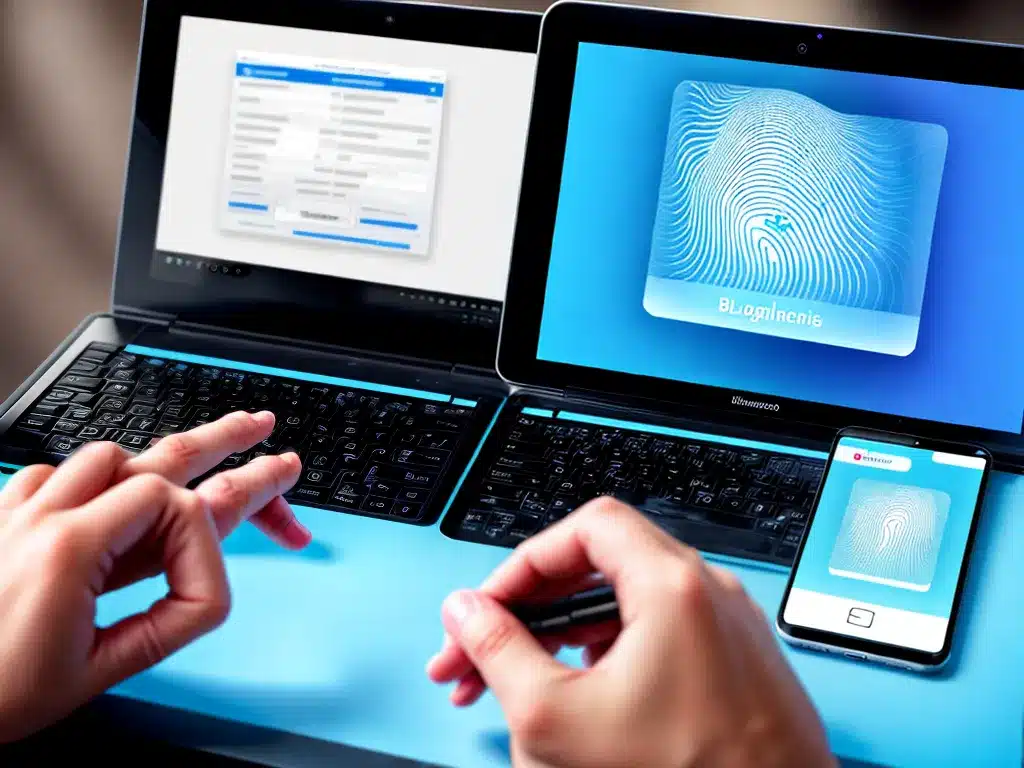Biometrics refer to metrics related to human characteristics and traits. Biometric authentication is used in computer science as a form of identification and access control. It is also used to identify individuals in groups that are under surveillance.
How Biometrics Work for Authentication
Biometric authentication technology works by comparing a biometric data capture to stored, confirmed authentic data in a database. Two main types of comparisons are used:
-
1-to-1: Comparing captured biometric data to specific stored data
-
1-to-many: Comparing captured biometric data to all stored data
To authenticate, the new biometric data and the stored data have to match based on set thresholds. The main types of biometric data used for authentication include:
- Fingerprint scans
- Facial recognition
- Iris recognition
- Voice recognition
- Vein pattern recognition
Advantages of Using Biometrics for Login Security
Using biometrics for login authentication provides several key advantages compared to traditional login methods like usernames and passwords:
- Increased security – Biometric traits are unique to each individual, making them more secure than passwords which can be guessed.
- Convenience – No need to remember complicated passwords. Biometric authentication is fast and easy for users.
- Difficult to replicate – Biological characteristics are hard to steal or replicate making account takeover difficult.
- Always available – Users do not need to carry any tokens. Biometric traits are always with the users.
Challenges and Limitations of Biometrics
While biometrics provide improved security over passwords, there are some limitations and challenges:
-
Spoofing – Some biometric traits like fingerprints can potentially be spoofed using replicas. Liveness detection needs to be used to counter spoofing.
-
Noise in data – Issues like dirt on a scanner can affect biometric data capture quality.
-
Enrollment issues – Not all biometric data enrolls properly resulting in authentication failures.
-
Latency – Processing and matching biometric data can slow down authentication. Optimized algorithms are required to reduce latency.
Commonly Used Types of Biometric Authentication
Some of the most widely used types of biometric authentication include:
Fingerprint Scans
Fingerprint authentication is one of the most prevalent biometric technologies used today. Key points:
-
Uniqueness – fingerprint ridges and patterns are unique to each person.
-
Ease of capture – special scanners can easily capture high quality fingerprint data.
-
Mass adoption – fingerprint scanners are widely used in devices like smartphones.
Facial Recognition
Facial recognition uses unique facial features to identify individuals. Key aspects:
-
Uses machine learning – facial recognition relies on neural networks and deep learning for identification.
-
Convenience – cameras can capture facial data without any user action needed.
-
Spoofing concerns – 2D images/videos of users can potentially spoof basic facial recognition. 3D depth sensing and liveness detection is required to counter spoofing.
Iris Recognition
Iris recognition uses the unique patterns in the colored ring of tissue surrounding the pupil. Key points:
-
Most accurate biometrics – iris patterns have a very high degree of randomness giving it the lowest false match rates.
-
Stability – irises remain unchanged from about 1 year of age throughout life.
-
Spoof resistance – irises are almost impossible to surgically replicate due to complexity.
When to Use Biometric Logins
Biometric authentication provides enhanced security over passwords. Some examples of when biometric logins are recommended:
- Government agencies and financial institutions handling sensitive data
- Critical infrastructure like data centers, power grids
- Devices handling confidential data like laptops, mobile phones
- High security locations like research labs, defense facilities
Ensuring Privacy with Biometrics
While biometrics provide security, privacy issues can arise from collection of personal data. Steps to ensure privacy include:
- Allowing users choice to opt-in and consent for biometric enrollment
- Anonymizing biometric data by avoiding storage of raw data or source images
- Secure storage of biometric data with encryption
- Controlled access to biometric data on a need-to-know basis
- Allowing users to delete their enrolled biometric data
The Future of Biometric Authentication
Biometric authentication is expected to grow significantly in the future driven by technology improvements like:
-
Multimodal biometrics – using multiple biometric types like face + fingerprint for enhanced accuracy.
-
Behavioral biometrics – authenticating based on patterns in human behaviors like keystroke dynamics.
-
Passive biometrics – authentication without any explicit user action required.
-
Emerging modalities – new biometric types like DNA, odor, or gait recognition.
Continued innovation in biometrics and machine learning will enable seamless and highly secure authentication experiences.













